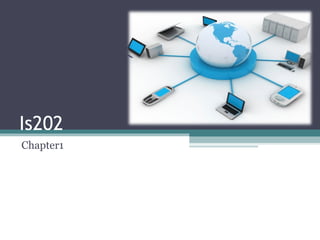
Is202 – workshop 1
- 2. LEARNING OUTCOMES • After reading this section, you should be able to: • Distinguish between data, information and knowledge • Describe and evaluate information quality in terms of its characteristics • Classify decisions by type and organisational level • Discuss the information needed to support decision making
- 3. Introduction • Data and information Managers in the work place use information to make decisions and ensure that information flows/ disseminates efficiently through the organization
- 4. Data in the information technology context! • Data is a collection of raw facts or observations about an organizations objectives. Data refers to the measurement of the attributes ( characteristics of an organization) such as daily sales figures, employee attendance etc. • Data on its own is not useful it must be analyzed and compiled into meaningful information for example: looking at a specific days sales is not helpful but when the same days sales are compared to a previous period it enables the manager to get information such as • How much did sales increase by? • What is the most popular product by sales? Etc.
- 5. Information : definition • Information is processed data that yields a meaningful context for the user. Data is then subjected to the value added process where by meaningful information is extracted from raw data and compiled into reports for the end user. • For example the daily sales for a firm is compiled into a monthly sales report for the sales manager. The data on its own does not hold much value but when the data is processed it yields information such as most popular product, frequency of transactions per customer, peak and off peak times. • The report allows the sales manger to identify these trends.
- 6. Value of information • Information value can be categorized into two classes tangible and intangible value. • It is often possible to measure the value of information directly. The tangible value of information is often measured in terms of financial value; an example can be the use of inventory information to improve stock control procedures. • VALUE OF INFORMATION – COST OF GATHERING INFORMATION • The intangible value of information is difficult or impossible to quantify, an example can be attempting to measure the extent to which information can improve decision behavior. IMPROVEMENTS IN DECISION BEHAVIOUR – COST OF GATHERING INFORMATION
- 7. • SOURCES OF INFORMATION • Information can be gathered through both formal and informal communication. Formal communications can include reports and accounting statements. Informal communications can include conversations and notes. Formal communication • Formal communication involves presenting information in a structured consistent manner. • Information communication • This describes less well-structured information that is transmitted by informal means such as casual conversations between members of staff.
- 8. ATTRIBUTES OF INFORMATION QUALITY A group of characteristics by which the quality of information can be assessed, normally grouped into categories of time, content and form. MANAGERIAL DECISON MAKING In order for an organization to function effectively all activities must be planned and monitored by managers according to well-informed decisions. The functions of management include forecasting, planning, organizing and coordination and control. One of the key management functions that information systems seek to support is managerial decision making. The way in which managers make decisions and the factors that influence those decisions are often described as decision behavior. Decisions can be classed as structured, unstructured or semi- structured.
- 9. Types of Decisions • Structured decisions • Situations where the rules and constraints governing are known, e.g. how would we process a sales order? • Unstructured decisions • Complex situations where the rules governing the decision are complicated or unknown, e.g. what should our distribution channels be? • Semi-structured decisions • Many decisions fall somewhere in between the two extremes, e.g. which foreign market should we target?
- 10. LEVELS OF MANAGERIAL DECISION MAKING • Strategic level • Managers are largely concerned with long term organizational planning. • Tactical level • Managers are largely concerned with medium term planning. • Operational level • Managers are largely concerned with short term planning and the day- to-day control of an organization's activities.
- 12. What is Knowledge? • Knowledge can be thought of as the combined result of a person‘s experiences and the information they possess. • Knowledge management (KM) is a fairly new term that describes a range of activities intended to make sure an organization uses its information resources as effectively as possible. Applications of KM include data mining, document image processing and business intelligence. • Competitive intelligence is an area of knowledge management concerned with helping organizations to respond effectively to competition by gathering and analyzing information about competitors.
Hinweis der Redaktion
- Attributes of information such as financial information.
